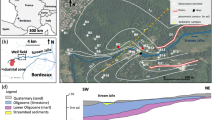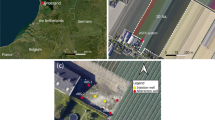Abstract
Background, Aims and Scope
Disposal of dredged material in subaqueous depots is increasingly considered an economic and ecologically sound option in managing contaminated dredged material. The concept of subaqueous disposals capped with active barrier systems has been developed to minimize this risk of contaminant release. As such a depot represents a permanent installation within a sensitive ecosystem, it requires a thorough monitoring concept. It is the goal of this work to develop such a concept regarding general considerations and results of laboratory and field investigations.
Methods
In addition to the state-of-the-art techniques developed for other under-water constructions, this monitoring concept is developed with particular respect to the chemical isolation of the dredged material from the overlying water body. It comprises the use of seepage meters, dialysis samplers, and DGT gel probes for determining the migration of selected target solutes. The capability of the dialysis samplers is demonstrated by comparing field results with model calculations. The appropriateness of DGT probes to assess the impact of humic substances on trace metal speciation and on copper toxicity is demonstrated with the aid of laboratory experiments.
Results and Discussion
The experimental results show that, by using dialysis samplers, the temporal changes in concentration-depth-profiles of heavy metals in the pore solution can be monitored. Additionally, the application of DGT probes facilitates the in situ detection of labile species of a metal in the presence of dissolved humic substances, which serves to reflect its toxicity. Conclusions. Three subsequent monitoring phases are distinguished on the basis of both general considerations and the findings from field results: A hydraulic phase that is characterized by compaction and pore water expulsion, a geochemical phase in which the demobilization of pollutants can occur due to substantial changes in the physico-chemical conditions (pH, EH), and a steady-state-phase where pore water flow and geochemical conditions are approaching their minimum.
Recommendations and Outlook
The monitoring concept suggested here provides a versatile tool to assess the chemical isolation of subaqueous sediment depots and other contaminated sediment sites. This is of great importance as subaqueous disposal is increasingly considered a future management strategy as space for upland disposal is limited and treatment, in general, proves to be too costly.
Similar content being viewed by others
References
Azcue JR, Rosa F, Lawson G (1996): An improved dialysis sampler for the in situ collection of larger volumes of sediment pore waters. Environ Technol 17, 95–100
Bertolin A, Rudello D, Ugo P (1995): A new device for in-situ pore-water sampling. Marine Chem 49, 233–239
Blanchfield PJ (1996): Use of seepagemeters to measure groundwater flow at brook trout redds. Trans. Am Fisheries Soc 125, 823–818
Brandi H, Hanselmann KW (1991): Evaluation of dialysis pore water samplers for microbiological studies at the sediment-water interfaces. Aquatic Sciences 53 (1) 55–73
Cable JE, Burnett WC, Chanton JP, Corbett DR, Cable PH (1997a): A field evaluation of seepage meters in a coastal marine aquifer. Estuarine, Coastal and Shelf Science 45, 367–375
Cable JE, Burnett WC, Chanton JP (1997b): Magnitude and variations of groundwater seepage along a Florida shoreline. Biogeochem 38, 189–205
Carignan R, Rapin F, Tessier A (1985): Sediment pore water sampling for metal analysis. Geochim Cosmochim Acta 49, 2493–2497
Davison G, Fones G, Harper M, Teasdale P, Zhang H (2000): Dialysis, DET and DGT: In-situ diffusional techniques for studying water, sediments and soils. In: Buffle, J. and G. Horvai: In-situ monitoring of aquatic systems — Chemical analysis and speciation. p 495–570, New York (Wiley)
Davison W, Zhang H (1994): In situ speciation measurements of trace components in natural waters using thin-film gels. Nature 367, 546–548
Hesslein RH (1976): An in-situ sampler for close interval pore water studies. Limnol. Oceanogr. 21, 912–914
Jacobs PH (2002): A new type of rechargeable dialysis pore water sampler for monitoring in-situ sediment caps. Water Res 36 (12) 3121–3129
Jacobs PH, Förstner U (1999): The concept of sub-aqueous in-situ cap** of contaminated sediments with active barrier systems (ABS) using natural and modified zeolites. Water Res 33 (9) 2083–2087
Jacobs PH, Förstner U (2001): Managing contaminated sediments IV: Subaqueous storage and cap** of dredged material. J Soils & Sediments 1 (4) 205–212
vd Kammer F, Thöming J, Förstner U (2000): Redox buffer concept as a tool for the assessment of long-term effects in natural attenuation / intrinsic remediation. In: Schüring J, Schulz HD, Fischer WR, Böttcher J, Duijnisveld WHM (eds.): Redox fundamentals, processes and applications. 251 pp, Berlin, Heidelberg, New York (Springer)
Mayer LM (1976): Chemical water sampling in lakes and sediments with dialysis bags. Limnol Oceanogr 21, 912–914
Möbius W (2002): New methods for the excavation and deposition of dredged material. Colloquium 20th Anniversary of Dept. Environmental Science and Technology, Technical University Hamburg-Harburg, 23 May 2002
PIANC (1998): Handling and treatment of contaminated dredged material (CDM) from ports and inland waterways, Volumes I+II. Permanent International Association of Navigation Congresses (PIANC). PTC1 Report of working group no. 17, supplement to Bulletin no. 89. Brussels (CD-ROM)
Shaw RD, Prepas EE (1989): Anomalous, short term influx of water into seepage meters. Limol. Oceanogr. 34, 1343–1351
Shi B, Allen HE, Desnoyers C (1998): Assessment of cadmium in aquatic sediment using dialysis damplers with ion-exchange-resin collection. Separation Sci Technol 33, 1013–1024
Taniguchi M, Fukuo Y (1993): Continuous measurements of ground-water seepage using an automatic seepage meter. Ground Water 31 (4) 675–679
Zhang H, Zhao F-J, Sun B, Davison W, Mcgrath SP (2001): A new method to measure effective soil solution concentration. Envir. Sci Techn. 35 (12)2602–2607
Author information
Authors and Affiliations
Corresponding author
Rights and permissions
About this article
Cite this article
Jacobs, P.H. Monitoring of subaqueous depots with active barrier systems for contaminated dredged material using dialysis samplers and DGT probes. J Soils & Sediments 3, 100–107 (2003). https://doi.org/10.1007/BF02991075
Received:
Accepted:
Issue Date:
DOI: https://doi.org/10.1007/BF02991075




